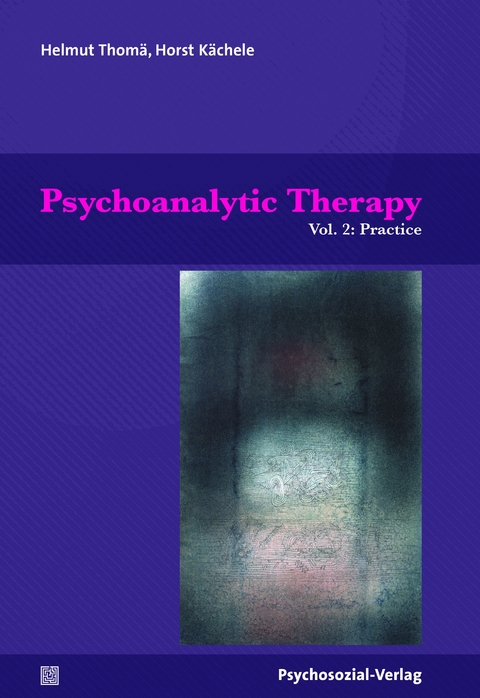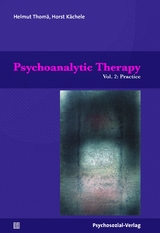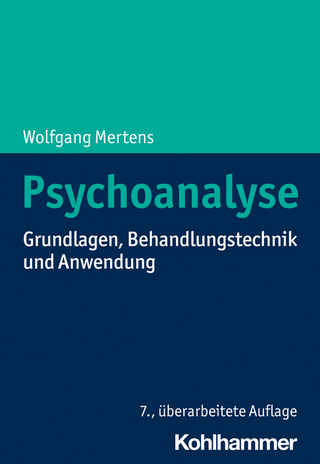Psychoanalytic Therapy
Psychosozial-Verlag
978-3-8379-2952-2 (ISBN)
Conversational analysis has turned out to be the salient feature to understand what promotes change in the psychoanalytic situation. This significant aspect of the first edition of this textbook is expanded in the second edition presenting prominent examples of contemporary process and outcome research fulfilling the criteria of evidence-based medicine.The case presentations included in this volume provide insight into thinking and acting in psychoanalysis and relate directly to the theories taught in Vol. 1: Principles.
ForewordPeter FonagyEndorsementAnna BuchheimPrefaceIntroductionIndex of Patient's Code Names1 Case Histories and Treatment Reports1.0 Introduction1.1 Back to Freud and the Path to the Future1.2 Case Histories1.3 Treatment Reports1.4 Approximating the Dialogue: Tape Recordings and Transcriptions2 Transference and Relationship2.0 Introduction 2.1 Therapeutic Alliance and Transference Neurosis 2.1.1 Promoting the Helping Alliance 2.1.2 Support and Interpretation 2.1.3 Common Ground and Independence 2.2 Positive and Negative Transference 2.2.1 Mild Positive Transference 2.2.2 Strong Positive Transference 2.2.3 Fusion Desires 2.2.4 Erotized Transference 2.2.5 Negative Transference2.3 Significance of the Life History 2.3.1 Rediscovery of the Father 2.3.2 Brother Envy 2.4 Transference and Identification 2.4.1 The Analyst as Object and as Subject 2.4.2 Identification with the Analyst's Functions3 Countertransference3.0 Introduction 3.1 Concordant Countertransference 3.2 Complementary Countertransference 3.3 Retrospective Attribution and Fantasizing 3.4 Making the Patient Aware of the Countertransference 3.4.1 Erotized Countertransference 3.4.2 Aggressive Countertransference 3.5 Irony 3.6 Narcissistic Mirroring and Selfobject 3.6.1 Mirror Image and Selfobject 3.6.2 Self-Psychological Perspective 3.7 Projective Identification 3.7.1 Notes on Projective Identification 3.7.2 Case 1: Johann Y 3.7.3 Case 2: Veronica X 4 Resistance4.0 Introduction 4.1 Disavowal of Affects 4.2 Pseudoautonomy 4.3 Unpleasure As Id Resistance 4.4 Stagnation and the Decision to Change the Analyst 4.5 Closeness and Homosexuality 4.6 Resistance and the Security Principle 5 Interpretation of Dreams5.0 Introduction 5.1 Self-Representation in Dreams 5.1.1 Dysmorphophobia and Spasmodic Torticollis 5.2 A Dream Sequence 5.2.1 Dream About an Injection 5.2.2 Dream About the Crane 5.2.3 Dream About Automobile Repairs 5.2.4 Dream About an Agent 5.2.5 Dream About an Amputation 5.2.6 Decapitation Dream 5.3 Dream About the Symptom 5.4 Thoughts About Psychogenesis 6 From the Initial Interview to Therapy6.0 Introduction 6.1 Initial Interview6.1.1 Searching for an Analyst 6.1.2 Attachment Interview as a Diagnostic Help 6.2 Specific Problems 6.2.1 Social Class 6.2.2 Delinquency6.2.3 Adolescence6.3 The Patient's Family 6.4 Third-Party Payment 6.4.1 Application Procedure 6.4.2 Peer Reviewing and Transference 7 Rules7.0 Introduction 7.1 Dialogue 7.2 Free Association 7.3 Evenly Suspended Attention 7.4 Questions and Answers 7.5 Metaphors 7.5.1 Basic Issues 7.5.2 Clinical Application 7.6 Value Freedom and Neutrality 7.7 Anonymity and Naturalness 7.8 Audio Tape Recordings 7.8.1 Examples 7.8.2 Counterarguments 8 Means, Ways, and Goals8.0 Introduction 8.1 Time and Place 8.1.1 Scheduling 8.1.2 Remembering and Retaining 8.1.3 Anniversary Reactions 8.2 Life, Illness, and Time: Reconstructing a History 8.3 Interpretations 8.4 Acting Out-Enactment 8.5 Working Through 8.5.1 Repetition of Trauma 8.5.2 Denial of Castration Anxiety 8.5.3 Splitting of Transference 8.5.4 Mother Fixation 8.5.5 Commonplace Mistakes 8.6 Interruptions9 The Psychoanalytic Process: Treatment9.0 Introduction 9.1 Anxiety and Neurosis 9.2 Anxiety Hysteria 9.2.1 Conversion and Body Image 9.3 Anxiety Neurosis 9.3.1 Separation Anxiety 9.3.2 Termination Phase 9.3.3 Confirmation and Self-Esteem 9.4 Depression 9.5 Anorexia Nervosa 9.6 Neurodermatitis 9.7 Nonspecificity 9.8 Regression 9.9 Alexithymia9.9.1 The Original Ideas 9.9.2 Current Concepts 9.10 Embodiment-A New Perspective 9.10.1 A Dynamic View of Memory 9.10.2 Embodied Cognitive Science 10 Evaluation10.0 Introduction 10.1 Consultation10.2 Theoretical Remarks About a "Good Hour" 10.3 Results 10.3.1 Systematic Outcome Research 10.3.2 Patients' Retrospective Views 10.3.3 Changes 10.3.4 Separation References Name Index Subje
| Erscheinungsdatum | 31.12.2020 |
|---|---|
| Reihe/Serie | Bibliothek der Psychoanalyse |
| Co-Autor | Anna Buchheim, Michael B. Buchholz, Harald Gündel, Marianne Leuzinger-Bohleber |
| Verlagsort | Gießen |
| Sprache | englisch |
| Maße | 165 x 240 mm |
| Gewicht | 1264 g |
| Themenwelt | Geisteswissenschaften ► Psychologie ► Psychoanalyse / Tiefenpsychologie |
| Schlagworte | clinical studies • Conversational Analysis • History of psychoanalysis • Mental disorder • Psychoanalysis • psychoanalytic practice • psychosomatic illness • Sigmund Freud |
| ISBN-10 | 3-8379-2952-3 / 3837929523 |
| ISBN-13 | 978-3-8379-2952-2 / 9783837929522 |
| Zustand | Neuware |
| Informationen gemäß Produktsicherheitsverordnung (GPSR) | |
| Haben Sie eine Frage zum Produkt? |
aus dem Bereich




